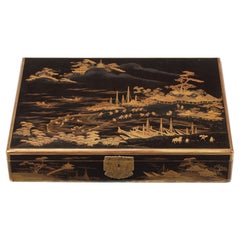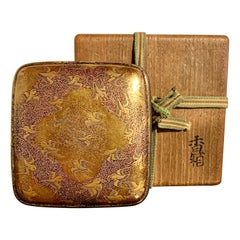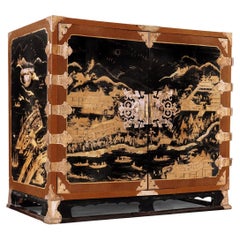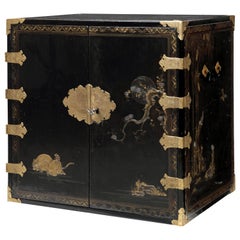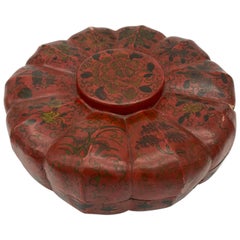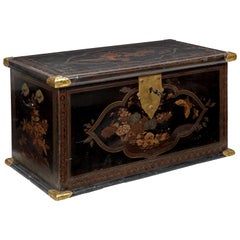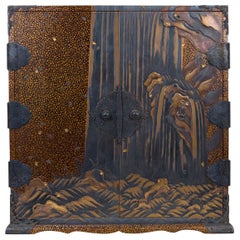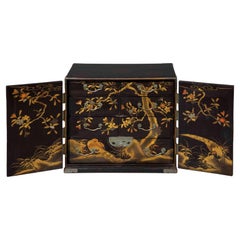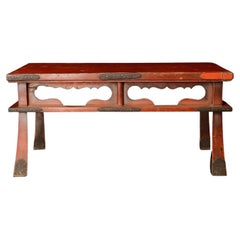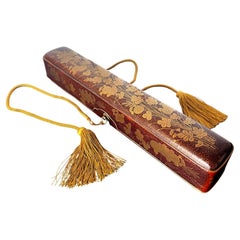17th Century Lacquer
to
1
12
11
24
85
310
192
10
103
50
13
10
1
12
8
1
4
3
3
17
12
11
5
5
24
24
18
6
24
24
24
Period: 17th Century
A superb Japanese export lacquer writing box
Located in Amsterdam, NL
Kyoto, circa 1680
The writing box has bevelled edges and a kabusebuta (overhanging lid), and is completely covered in black lacquer in maki-e and decorated in gold, silver and red h...
Category
Japanese Antique 17th Century Lacquer
Materials
Lacquer
Japanese Lacquer Incense Box, Kogo, Momoyama or Edo Period, 16th/17th Century
Located in Austin, TX
A wonderful Japanese lacquer incense box, kogo, with a design of plovers in flight, late Momoyama or early Edo Period, circa 1600, Japan.
The small box, called a kogo, was used to s...
Category
Japanese Edo Antique 17th Century Lacquer
Materials
Gold, Pewter
17th Century Japanese Export Lacquer Cabinet with Depiction the Dutch Tradepost
Located in Amsterdam, NL
A highly important Japanese export lacquer cabinet with depiction of the Dutch East India Company tradepost Deshima and the annual Dutch delegation on its way to the Shogun in Edo
Edo period, circa 1660-1680
H. 88 x W. 100.5 x D. 54 cm
This cabinet includes a later European japanned stand, but also a modern powder-coated steel frame.
The latter can be designed and added to your specific needs.
The sides and front of the rectangular two-door cabinet are embellished in gold and silver hiramaki-e and takamaki-e on a black roiro lacquer ground with a continuous design. The two doors depict a long procession of numerous figures travelling on foot and horseback along buildings and a pagoda into a mountainous landscape. This is the annual court journey, Hofreis, of the Dutch from Nagasaki to the Shogun’s court in Edo. Three horseback riders are dressed as Dutch merchants and a fourth figure, probably het Opperhoofd, is seen inside a palanquin, norimon. Just about to cross the bridge, two men are carrying a cabinet like the present one.
Many Japanese figures on either side of the procession are engaged in various activities; some play musical instruments on board of small boats, others are fishing; figures inside buildings are depicted playing go, and farmers are tending to their rice paddocks. The upper part of the right door shows a large mansion, probably the local daimyo’s castle, with men kneeling before a man in the central courtyard.
The court journey fits in with the foreign policy of the shogunate which accorded a role to the VOC alongside China, Korea, and the Ryukyu Islands who also had to pay tribute. However, the VOC employees were traders, having low status in Japan’s social hierarchy, and they were received with less deference than were the state embassies from Korea and the Ryukyu Islands. Nevertheless, the contacts with the Dutch were a welcome source of information to the Shogun about Europe and European science and technology.
The left side of the cabinet depicts, in mirror image, a rare view of the artificial fan-shaped Deshima Island, the trading post for the Dutch in Japan. The island, where the Dutch flag flies, is surrounded by small Japanese boats and an anchored three-masted fluyt (cargo ship), flying Dutch flags, with on the stern the VOC monogram. On the bottom right a busy street of Nagasaki is shown, bordered by shops and leading up to the stone bridge. On the island the trees are beautifully painted, two cows can be seen, and the flagpole, all in very fine detail. Dutchmen and enslaved Malay are visible outside the buildings and two Japanese figures, probably guards, sit in a small hut in the centre.
A maximum of fifteen to twenty Dutchmen lived on the island at any time and soldiers or women were not allowed. Restrictions on Deshima were tight, and the merchants were only allowed to leave the island by special permission. The Opperhoofd had to be replaced every year, and each new Opperhoofd had to make a court journey to pay tribute, present gifts, and to obtain permission to Margaret Barclay eep on trading. In the distance, many birds fly above the hills and a four-story pagoda can be seen. The right side of the cabinet is painted with other horse riders and their retinue journeying through mountains.
The pair of doors to the front open to reveal ten rectangular drawers. The drawers are decorated with scenes of birds in flight and landscapes with trees and plants. The reverse of the left door with two thatched buildings, one with a ladder, underneath a camelia tree with large blooms; the right door with a three-story pagoda nestled among trees and both doors with a flying phoenix, ho-oo bird. The cabinet, with elaborately engraved gilt copper mounts, hinges, lock plates and brass handles, is raised on an 18th-century English japanned wood stand.
A pair of large cabinets...
Category
Japanese Edo Antique 17th Century Lacquer
Materials
Copper, Gold
Rare Charming 17th Century Japanese Lacquer Cabinet with Gilt-Bronze Mounts
Located in Amsterdam, NL
A fine Japanese pictoral style lacquer cabinet with gilt-metal mounts
Kyoto, Edo period, 1670-1690
Decorated in Japanese relief lacquer work, black lacquer ground decorated...
Category
Japanese Antique 17th Century Lacquer
Materials
Bronze
$44,915 Sale Price
25% Off
Qing Dynasty Chinese Red Lacquer Box
Located in Brea, CA
Chinese red lacquer box from Qing dynasty. Includes nine-pieces. Before in excellent condition. But when I take pictures, accidentally fell t...
Category
Chinese Qing Antique 17th Century Lacquer
Materials
Lacquer
Large Royal Early 17th Century Japanese Lacquer Chest with Gilt-Bronze Mounts
Located in Amsterdam, NL
A large Japanese transitional lacquer chest with gilt-metal mounts
Edo period, early 17th century
The rectangular chest with flat hinged lid decorated in gold, silver, and red ...
Category
Japanese Antique 17th Century Lacquer
Materials
Bronze
An exceptional Namban 'escritório' writing-box, with a single drawer
Located in Amsterdam, NL
Kyoto, Late Momoyama to Edo period, circa 1590-1630
Decorated in pearl shell and gold with branches, leaves and flowers inside cartouches on a pearl shell mosaic background.
H. 25 ...
Category
Japanese Antique 17th Century Lacquer
Materials
Gold
Japanese Negoro Style Lacquered Worship Stand, 17th-18th Century
Located in Fukuoka, JP
"Discover a piece of Japanese religious heritage with this exceptional Negoro lacquered stand. Crafted in the 17th to 18th century, this worship article stand is a prime example of e...
Category
Japanese Edo Antique 17th Century Lacquer
Materials
Wood, Lacquer
Unique 17th Century Miniature Japanese Namban Lacquer Miniature Dollhouse Chest
Located in Amsterdam, NL
A unique and exceptional Japanese miniature or dollhouse export lacquered chest
Kyoto, circa 1620-1640
The chest of rectangular shape with a domed lid, decorated in Transition-style, in gold hiramaki-e on a black background within reserved lobed cartouches decorated with landscapes animated with birds and rabbits, on a shagreen or samegawa background. The borders are decorated with geometric friezes, the box with gilt-copper mounts, the interior decorated in red lacquer.
Measures: H 9.2 x W 14.5 x D 7.2 cm
This miniature is of exceptional quality and a perfect copy of the famous large size Transition-style coffers. It was most likely ordered by a Dutch lady for her dollhouse (poppenhuis), like the famous Petronella Oortman (1656-1716) doll-house, which is now one of the highlights in the collection of the Rijksmuseum Amsterdam, or Petronella Oortmans-de la Court’s (1624-1707) dollhouse in the collection of the Centraal Museum Utrecht. Sara Rothé of Amsterdam in 1743 ordered a miniature black lacquered ivory tripod table with gold chinoiserie decoration by Jurriaan Buttner (Monika Kopplin, European Lacquer, 2010, p. 56).
Other Japanned dollhouse...
Category
Japanese Edo Antique 17th Century Lacquer
Materials
Shagreen, Cypress
Japanese Lacquered Maki-E Fubako in Kodaiji Style
Located in Atlanta, GA
A rare Japanese lacquered wood fubako decorated in Kodaiji maki-e style circa early 17th century the beginning of the Edo period, possibly early toward the end of the Azuchi-Momoyama period. The rectangular, long and slim box features a deep lipped lid with slightly rounded corners, a conforming lower box with two bronze medallion rings with tasseled...
Category
Japanese Edo Antique 17th Century Lacquer
Materials
Wood, Lacquer
Fine Japanese Namban Lacquer Jewelry Casket, 17th Century
Located in Amsterdam, NL
Japanese Namban lacquer transition-style coffer with two drawers
Kyoto/Nagasaki, circa 1650
The cartouches with gilt and red decorations of leaves...
Category
Japanese Edo Antique 17th Century Lacquer
Materials
Cypress
Rare 17th Century Japanese Export Lacquer Medical Instrument Box
Located in Amsterdam, NL
A rare Japanese export lacquer medical instrument box
Edo-period, 1650-1700
L. 19 x W. 6 x H. 8.5 cm
This unconventionally shaped lacquer b...
Category
Japanese Edo Antique 17th Century Lacquer
Materials
Gold
17th Century Set of 8 Chinese Lacquer Silver Cups with Mother of Pearls
Located in Brea, CA
Antique 17th century set of 8 Chinese lacquer cups with silver liner in interior of each cup with color of mother of pearls.
Category
Chinese Qing Antique 17th Century Lacquer
Materials
Lacquer
Antique Japanese Lacquered Incense Box Kobako Ex-Christie's
Located in Atlanta, GA
An old Japanese lacquered small box likely used to contain incense powder called Kobako, circa Momoyama to early Edo period (16-17th century). The rectangular form box with a fitted ...
Category
Japanese Japonisme Antique 17th Century Lacquer
Materials
Lead
Early 17th century 'Incense Burner' ( Koro)
Located in Hudson, NY
Early 17th century incense burner( Koro) in basket weave nashiji lacquer pattern with chrysanthemum mons (the national symbol of Japan). Copper grill with detailed waves pattern. Foo...
Category
Japanese Antique 17th Century Lacquer
Materials
Copper
Chinese Black Lacquered Wood Box - Imperial Dragons - Ming Period Wanli 17th
Located in Beuzevillette, FR
Magnificent box Imperial jewelry box in black lacquered wood decorated with dragons.
This wonderful box is lacquered on a black background with patt...
Category
Chinese Ming Antique 17th Century Lacquer
Materials
Wood
Early 17th Century Negoro Lacquer Footed Bowl
Located in Hudson, NY
Early 17th century Negoro lacquer footed bowl, Edo period (1603-1868) round bowl with tripod cabriole style legs. Negoro lacquer (monk's lacquer in red ...
Category
Japanese Edo Antique 17th Century Lacquer
Materials
Lacquer
Fine 17th Century Japanese Export Black and Gold Lacquered Pictorial-Style Dish
Located in Amsterdam, NL
A fine Japanese export black and gold lacquered pictorial-style dish Nagasaki or Kyoto, 1680-1720
The dish with wide flat rim of Keaki wood (Zelkova species) in black lacquer with...
Category
Japanese Edo Antique 17th Century Lacquer
Materials
Gold
17th Century Qing Dynasty Set of 5 Chinese Bamboo Tea Cups with Silver Inlaid
Located in Brea, CA
A fine set of 5pieces Chinese bamboo tea cups with silvered interiors from the 17th century Qing Dynasty, the faces each of each decorated t...
Category
Chinese Qing Antique 17th Century Lacquer
Materials
Bamboo
17th Century Pair of Chinese Silver Lacquer Plates with Mother of Pearl
Located in Brea, CA
Pair of Chinese silver, lacquer, and mother of pearl plates from the 17th century. A matching pair of ornamental antique Chinese plates, the faces ...
Category
Chinese Qing Antique 17th Century Lacquer
Materials
Lacquer
Large Chinese Wooden Lacquered Box Decorated with Birds and Vegetal Motif
Located in Brea, CA
Chinese Art. A large wooden lacquered box decorated with birds and vegetal motif China, Ming dynasty, 17th century. 36cm x 6.5cm. Condition see more...
Category
Chinese Ming Antique 17th Century Lacquer
Materials
Lacquer
Pair of Exceptional Daimyo Hand Warmers
Located in Hudson, NY
The daimyo were the ruling class of land owners, subordinate to shogun, who formed around the 10th century and fell out of power in the 19th century. Daimyo families tended to be wealthy and could commission artwork or decorative pieces. This pair of 17th century hibachi are black and gold lacquer with designs of Uji Bridge...
Category
Japanese Edo Antique 17th Century Lacquer
Materials
Lacquer
$65,000 / set
Extremely Fine and Rare 17th-Century Japanese Export Lacquer and Inlaid Cabinet
Located in Amsterdam, NL
An extremely fine and important Japanese lacquer cabinet with gilt-copper mounts for the European market
Edo period, late 17th century
The pictorial style decorated rectangular...
Category
Japanese Antique 17th Century Lacquer
Materials
Brass
17th-Century Japanese Namban Lacquer Coffer on French Stand, Possibly by Boulle
Located in Amsterdam, NL
An impressive and large Japanese 'Namban' transition-style lacquer coffer with fine gilt copper mounts on a French Re´gence base, possibly by André-Charles Boulle (1642-1732)
Kyoto, 1640-1650, the base 18th century
?The coffer with shaped cartouches on a nashiji ground on the lid, front and sides, with fine decorations in various techniques: takimaki-e (high relief), tsuke-gaki (drawing with narrow lacquer lines and over sprinkling with gold and silver), usuniku-takamei-e (demi relief), kimekomi (pushed inside) and accents of kirigane (small geometrical metal mosaics). Inside the cartouche on the lid a landscape with volcanos...
Category
Japanese Antique 17th Century Lacquer
Materials
Brass, Ormolu
Related Items
Japanese 19th Century Miniature Lacquer Chest with Waterfall
Located in Hudson, NY
Japanese 19th century miniature lacquer chest with waterfall. Late Edo to early Meiji period lacquer chest (mid to late 19th century) with two characters on the front reading Nuno an...
Category
Japanese Antique 17th Century Lacquer
Materials
Gold, Silver, Bronze
19th Century Japanese Lacquer Table Cabinet
Located in Richmond, London
A fine and rare Japanese black lacquer table or jewellery cabinet, exquisitely decorated in intricate detail, dating to the late Meiji per...
Category
Japanese Meiji Antique 17th Century Lacquer
Materials
Metal
Japanese Lacquered Tebako 'Box'
Located in PARIS, FR
Tebako box with three compartments in golden and nashi-ji lacquer, decorated with golden, red, and kirigane lacquer, golden persimmon tree leaves, among rocks. The compartments are of increasing size from the top. The decoration is in continuity.
Persimmon has been cultivated in southern China for more than 2500 years and is believed to have been introduced to Japan in the 8th century. The veneer is a tree with very hard wood, similar to ebony. According to a legend, one specimen survived the atomic bombing of Nagasaki on August 9, 1945, close to the epicenter. It is therefore in Japan a symbol of strength and longevity. It is also the national fruit of the country. It is eaten as a traditional dish during New Year's Day celebrations.
Tebako literally means "portable box...
Category
Japanese Antique 17th Century Lacquer
Materials
Lacquer
Japanese Lacquer Meiji Period Cabinet on Stand, circa 1890
Located in Brighton, Sussex
A exquisite, fine quality Meiji period (1868-1912) Japanese black lacquer cabinet on stand with wonderful scrolling gilded decoration. H...
Category
Japanese Japonisme Antique 17th Century Lacquer
Materials
Lacquer
Antique Japanese Ink Stone Maki-e Lacquer Box Suzuribako Edo Provenance
Located in Atlanta, GA
A Japanese ink stone box (known as Suzuribako) with exquisite maki-e decoration from Edo period (circa mid-18th century). The box features a rectang...
Category
Japanese Edo Antique 17th Century Lacquer
Materials
Wood, Lacquer
$9,600
H 2.25 in W 98.75 in D 9.5 in
Pair of Chinese Export Bronze-Mounted Red Lacquer and Parcel-Gilt Cabinets
Located in Hudson, NY
On later stands, each fitted with a pair of cabinet doors opening to shelves. Loose translation of the calligraphy across the four doors reads:
"Going tens of miles in Jiangnan in ...
Category
Chinese Antique 17th Century Lacquer
Materials
Lacquer
$54,000 / set
H 60.5 in W 36.25 in D 24 in
Important Early Edo Period 17th Century Miniature Japanese Lacquer Cabinet
Located in Oxfordshire, United Kingdom
A Rare and Important 17th Century Miniature Japanese Lacquer Cabinet, 19 cm H, 17cm W, 16.5cm D.
The exquisitely decorated cabinet depicts fine floral raised scenes to each side. l...
Category
Antique 17th Century Lacquer
Materials
Lacquer
$49,550
H 7.49 in W 6.7 in D 6.5 in
Rare Meiji Period Japanese Lacquer Cabinet
Located in West Palm Beach, FL
Large, rare and important Meiji period, late 19th century, Japanese lacquer cabinet
Meiji period (1868-1912)
19th century
In three parts, desi...
Category
Antique 17th Century Lacquer
Materials
Wood
Japanese Lacquer Ryoshibako Document Box Meiji Period
Located in Atlanta, GA
A large Japanese lacquer box with elaborate Maki-e design from Meiji period, (mid-late 19th century). The generous size of the box was reser...
Category
Japanese Japonisme Antique 17th Century Lacquer
Materials
Wood, Lacquer
19th Century Chinese Export Table Top Black Lacquer Jewelry/Valuables Cabinet
Located in Incline Village, NV
Chinoiserie hand painted 19th century Chinese export jewelry cabinet circa 1880; is fronted by a pair of raised panel double doors; decorated in gilt with scenes of Chinese figures, ...
Category
Chinese Qing Antique 17th Century Lacquer
Materials
Wood
$1,485
H 17 in W 14 in D 7 in
Japanese Negoro Style Lacquered Worship Stand, 17th-18th Century
Located in Fukuoka, JP
"Discover a piece of Japanese religious heritage with this exceptional Negoro lacquered stand. Crafted in the 17th to 18th century, this worship article stand is a prime example of e...
Category
Japanese Edo Antique 17th Century Lacquer
Materials
Wood, Lacquer
$1,780
H 6.11 in W 10.63 in D 20.08 in
Japanese Maki-e Lacquer Stack Box Jubako
Located in Atlanta, GA
An antique jubako (stack boxes) with five tiers in an elongated octagon shape circa 19th century (end of Edo or beginning of Meiji period). jubako was traditionally used to store and...
Category
Japanese Japonisme Antique 17th Century Lacquer
Materials
Wood, Lacquer
Previously Available Items
17th Century Japanese Negoro Style Lacquered Stand
Located in Fukuoka, JP
A Rare Negoro Lacquer Buddhist Stand
This rare and historic Negoro lacquer Buddhist stand is a beautiful example of Japanese craftsmanship. It is made of wood with Negoro-style lacq...
Category
Japanese Antique 17th Century Lacquer
Materials
Lacquer, Wood
Japanese Lacquered Maki-E Fubako in Kodaiji Style
Located in Atlanta, GA
A rare Japanese lacquered wood fubako decorated in a Kodaiji maki-e style circa 17th century (early Edo period). The long and slender rectangular box features a deep lid with slightly rounded corners, fitting on a conforming lower box with two bronze medallion rings with tasseled...
Category
Japanese Edo Antique 17th Century Lacquer
Materials
Wood, Lacquer
Four magnificent 17th-century Japanese export gold lacquer Liquor or Gin bottles
Located in Amsterdam, NL
A set of four extremely rare and important pictorial-style Japanese export lacquer bottles
Edo-period, circa 1650-1680
H. 15.5 x W. 6.9 x B. 7.6 cm (each)
The bottles with red cop...
Category
Japanese Edo Antique 17th Century Lacquer
Materials
Copper, Gold, Silver
H 6.11 in W 2.72 in D 3 in
Antique Japanese Lacquered Incense Box Kobako
Located in Atlanta, GA
An old lacquered small box that was likely used to contain incense powder (it is called Kobako), circa Momoyama to early Edo period (17th century). The square form box with a fitted ...
Category
Japanese Edo Antique 17th Century Lacquer
Materials
Wood, Lacquer
Exceptional Dutch Lacquered Chinoiserie Cabinet on Stand, 17th Century
Located in Amsterdam, NL
An exceptional Dutch lacquered cabinet on stand with chinoiserie decoration`
Holland, late 17th century`
Pinewood covered in black linseed-oil varnish and gold decorations of birds flying over flowering trees and pavilions at the water side.
Measures: H. 192.5 x W. 140 x D. 59 cm
Dutch Chinoiserie Cabinets...
Category
Dutch Chinoiserie Antique 17th Century Lacquer
Materials
Pine, Lacquer
H 75.79 in W 55.12 in D 23.23 in
Antique Japanese Lacquered Incense Box Kobako
Located in Atlanta, GA
An old and exquisite Japanese lacquered small box likely used to contain incense powder (it is called Kobako), circa Momoyama to Edo period (17th century). The rectangular form box w...
Category
Japanese Japonisme Antique 17th Century Lacquer
Materials
Wood, Lacquer
Exquisite Early Japanese Lacquer Kobako Box with Insert Tray
Located in Atlanta, GA
An early Japanese lacquer kobako (small box) in octagon shape circa 16th-17th century (late Muromachi to Momoyama period). This kobako was possibly used as...
Category
Japanese Japonisme Antique 17th Century Lacquer
Materials
Silver
Large Japanese Lacquer Box Early Edo Period Ex-Christie's
Located in Atlanta, GA
A large lacquer Ryoshibako (Paper box in Japanese) finely decorated with Maki-e circa 17th century early Edo period. The box is of an impressive size and was used to store paper documents. Both sides of the lid were elaborately decorated with maki-e and the edge was befitted with lead rim, an early practice before the silver rim became common later. The interior and base were finished in Nashiji. The night scene on top surface of the lid depicts flocks of chidoris flying in formation from a sea shore swaying with reeds under a full moon, using hiramaki-e in both gold and silver. Ribbons of clouds were achieved with different densities of gold powder. The underside, in contrast, shows a crescent moon in takamakie-e above the sea with ferns and reeds. Chidoris, the plovers, are symbolic in Japanese culture as "thousands of blessings" and longevity. The Namichidori, the pattern in which the chidori flies in the nami (wave) represents the eternal love and safety of couples and families. For detailed references on the historical background and the use of chidoris on lacquerware, see the reference below.
This very lacquer box was featured for sale as lot 339 in Christie's London Sale Japanese Art...
Category
Japanese Japonisme Antique 17th Century Lacquer
Materials
Wood, Lacquer
Miniature 17th Century Japanese Lacquer Jewelry Cabinet with Gilt-Bronze Mounts
Located in Amsterdam, NL
Possibly unique small cabinet
Japan, Edo period, 17th century
Black lacquered wood (Urushi), decorated with gold
lacquer (Maki-e) and gilt copper mounts.
Measures: Height 18.5 ...
Category
Japanese Edo Antique 17th Century Lacquer
Materials
Bronze
H 7.29 in W 6.66 in D 6.66 in
Chinese Ming Carved & Lacquered Wooden Dignitary on Horseback Figure
Located in Bishop's Stortford, Hertfordshire
A finely carved Chinese antique Ming wooden figure of a dignitary seated on a throne and riding on horseback dating from the early 17th century. The figure...
Category
Chinese Ming Antique 17th Century Lacquer
Materials
Wood
Ming Dynasty Chinese Red Lacquer Box
Located in Brea, CA
Chinese red lacquer box from Ming or Yuan dynasty. Includes nine-pieces. In excellent condition.
Category
Chinese Ming Antique 17th Century Lacquer
Materials
Lacquer
Japanese Kodai-ji Style Lacquer Incense Burner, Akoda Koro, Momoyama Period
Located in Austin, TX
A fine and rare Japanese Momoyama Period (1573 to 1615), lobed lacquer incense burner, akoda koro, 16th-17th century, Japan.
The lobed censer, called an akoda koro (pumpkin or mel...
Category
Japanese Edo Antique 17th Century Lacquer
Materials
Silver
Recently Viewed
View AllMore Ways To Browse
Large Japanese Lacquer Box
Meiji Japan Tray
Lacquered Japanese Bowl
Japanese Comb
Japanese Lacquered Miniature
Japanese Red Lacquer Tray
Japanese Lacquer Plaque
Large Cinnabar
Chinese Carved Cinnabar Red Lacquer
Korean Mother Of Pearl Furniture
Korean Mother Of Pearl
Japanese Lacquer Ware
Antique Chinese Cinnabar Lacquer
Japanese Lacquered Trunk
Chinese Red Lacquer Tray
Red Lacquer Ware
Burmese Lacquer Trays
Japanese Makie Lacquer
